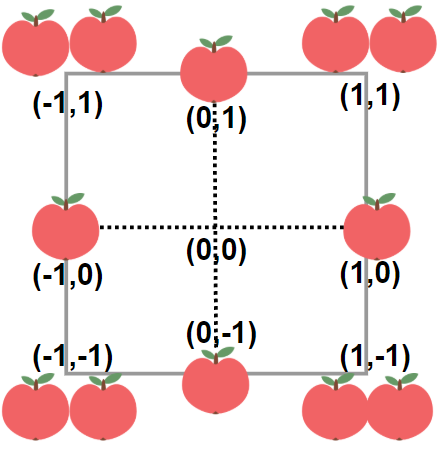- {x}
- Largest Number After Mutating Substring
- Maximum Compatibility Score Sum
- Delete Duplicate Folders in System
- Strong Friendship
- Maximum of Minimum Values in All Subarrays
- All the Pairs With the Maximum Number of Common Followers
- Three Divisors
- Maximum Number of Weeks for Which You Can Work
- Minimum Garden Perimeter to Collect Enough Apples
- Count Number of Special Subsequences
- Minimum Time For K Virus Variants to Spread
- Delete Characters to Make Fancy String
- Check if Move is Legal
- Minimum Total Space Wasted With K Resizing Operations
- Maximum Product of the Length of Two Palindromic Substrings
- Check If String Is a Prefix of Array
- Remove Stones to Minimize the Total
- Read More...

Minimum Garden Perimeter to Collect Enough Apples
In a garden represented as an infinite 2D grid, there is an apple tree planted at every integer coordinate. The apple tree planted at an integer coordinate (i, j) has |i| + |j| apples growing on it.
You will buy an axis-aligned square plot of land that is centered at (0, 0).
Given an integer neededApples, return the minimum perimeter of a plot such that at least neededApples apples are inside or on the perimeter of that plot.
The value of |x| is defined as:
xifx >= 0-xifx < 0
Example 1:

Input: neededApples = 1 Output: 8 Explanation: A square plot of side length 1 does not contain any apples. However, a square plot of side length 2 has 12 apples inside (as depicted in the image above). The perimeter is 2 * 4 = 8.
Example 2:
Input: neededApples = 13 Output: 16
Example 3:
Input: neededApples = 1000000000 Output: 5040
Constraints:
1 <= neededApples <= 1015
Solution Explanation for Minimum Garden Perimeter to Collect Enough Apples
This problem asks for the minimum perimeter of a square plot centered at (0,0) containing at least neededApples. The number of apples in a square plot with side length k is given by the formula: 2 * k * (k + 1) * (2 * k + 1). This formula is derived by summing the apples in each concentric square layer of the plot.
We can solve this problem using two main approaches:
Approach 1: Iterative Solution
This approach directly utilizes the formula for the number of apples. It iterates through possible side lengths (x), calculating the number of apples for each until the required number of apples is met or exceeded.
Code (Python):
class Solution:
def minimumPerimeter(self, neededApples: int) -> int:
x = 1
while 2 * x * (x + 1) * (2 * x + 1) < neededApples:
x += 1
return x * 8Explanation:
- The loop starts with
x = 1(side length). - The
whilecondition checks if the number of apples for the currentxis less thanneededApples. - If the condition is true, it means we need a larger plot, so
xis incremented. - Once the loop terminates,
xrepresents the minimum side length. - The perimeter is calculated as
x * 8(4 sides * side length * 2) and returned.
Time Complexity: O(√N), where N is neededApples. The loop iterates approximately up to the square root of neededApples.
Space Complexity: O(1) - Constant extra space is used.
Approach 2: Binary Search
This approach employs binary search to efficiently find the minimum side length. Binary search is suitable because the number of apples is a monotonically increasing function of the side length.
Code (Python):
class Solution:
def minimumPerimeter(self, neededApples: int) -> int:
l, r = 1, 100000 # reasonable upper bound
while l < r:
mid = (l + r) // 2
if 2 * mid * (mid + 1) * (2 * mid + 1) >= neededApples:
r = mid
else:
l = mid + 1
return l * 8Explanation:
landrdefine the search space (initially 1 to a large upper bound).- The
whileloop performs binary search. midcalculates the middle point.- The
ifcondition checks if the number of apples formidis greater than or equal toneededApples. - If true, it means the minimum side length could be smaller or equal to
mid, soris updated tomid. - Otherwise, the minimum side length must be greater than
mid, solis updated tomid + 1. - Finally,
lwill hold the minimum side length, and the perimeter is calculated.
Time Complexity: O(log N), where N is neededApples. Binary search has logarithmic time complexity.
Space Complexity: O(1) - Constant extra space is used.
Conclusion:
Both approaches correctly solve the problem. The binary search approach is more efficient for large values of neededApples due to its logarithmic time complexity. The iterative solution is simpler to understand and implement but less efficient for extremely large inputs. The choice of approach depends on the trade-off between code simplicity and performance requirements. The provided code snippets in other languages (Java, C++, Go, TypeScript) follow the same logic as the Python examples.